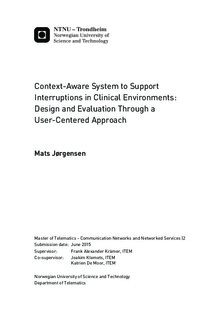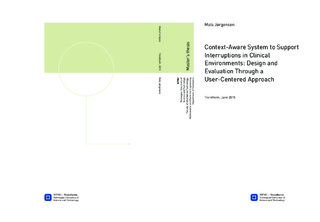| dc.description.abstract | Nurses may experience interruptions as double-edged swords as interruptions are essential tools to maintain awareness at the bed area while at the same time being harmful, disrupting current tasks and challenging cognitive capacity. This thesis seeks to reduce the impact of harmful interruptions by modifying notification of nurse calls using technologies for supporting context-awareness.
We use a nurse call prototype, developed on the Android platform, to enable research on the topic. The system has support for sensing the location of nurses by using low energy Bluetooth technology and Raspberry Pis, equipped with Bluetooth andWi-Fi dongles.
To create the best possible conditions for user acceptance, this study adopts a user-centered approach and is based on iterative involvement of users (nurses). We conduct an initial study, where six full-time nurses are interviewed to gain a better understanding of context and nurse practices. We use the results of this study to develop a new iteration of the nurse call system, which in turn are evaluated by performing four workshops with seven nurses. The methods of the workshops include role-playing, focus group interviews, and a combination of cognitive walkthrough and think-aloud.
Results include how to design, develop and integrate an interruption management system into a nurse call system. Gathering and handling sensor data using smart communication protocols is essential to ensure proper integration of the many system components. State Machines are excellent for ensuring correct and efficient handling of the many system states when modifying notification based on subtle changes in context.
Further results include situations where the system can infer context automatically, such as sterile procedures, night shifts, or leaving the department. A combination of location and time sensor data is enough for the system to infer context accurately in most situations. However, some scenarios are prone to incorrect context inferring like, for instance, difficult conversations, or in case of fatalities. We can handle incorrect inferring by providing easily accessible interfaces to enable manual updating of nurse availability statuses. | |

